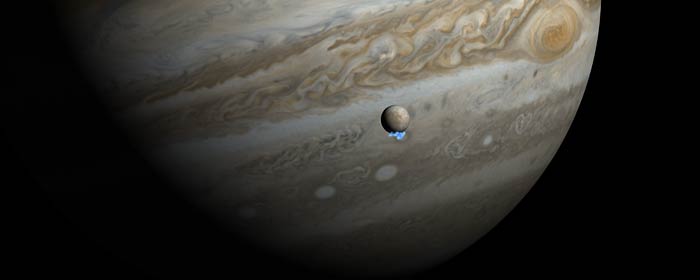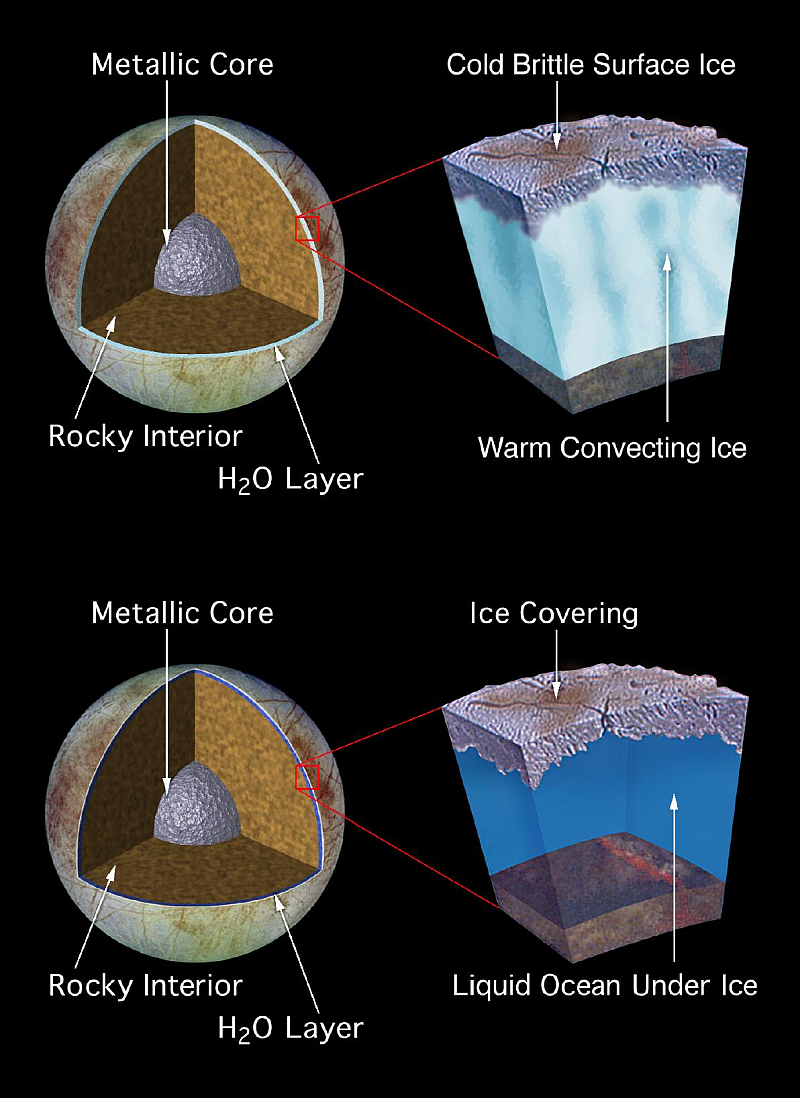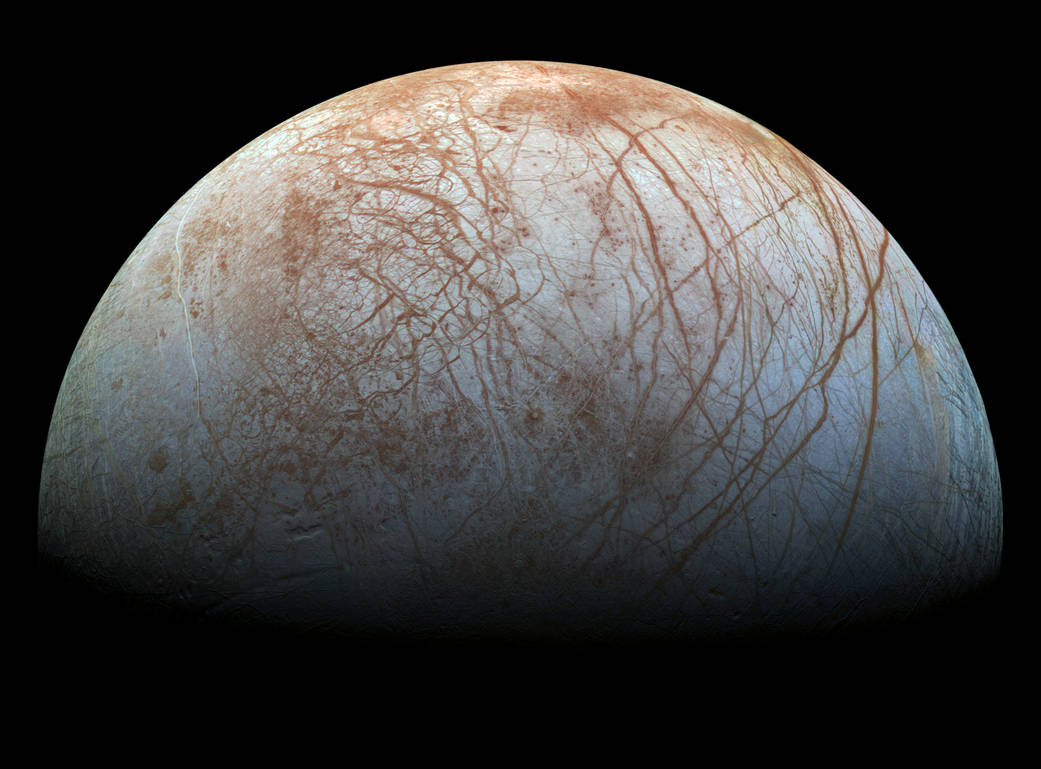NASA will make a “surprising” announcement about Jupiter’s moon Europa on Monday, Sept. 26th, at 2:00 PM EDT. They haven’t said much, other than there is “surprising evidence of activity that may be related to the presence of a subsurface ocean on Europa.” Europa is a prime target for the search for life because of its subsurface ocean.
The new evidence is from a “unique Europa observing campaign” aimed at the icy moon. The Hubble Space Telescope captured the images in these new findings, so maybe we’ll be treated to some more of the beautiful images that we’re accustomed to seeing from the Hubble.

We always welcome beautiful images, of course. But the real interest in Europa lies in its suitability for harboring life. Europa has a frozen surface, but underneath that ice there is probably an ocean. The frozen surface is thought to be about 10 – 30 km thick, and the ocean may be about 100 km (62 miles) thick. That’s a lot of water, perhaps double what Earth has, and that water is probably salty.
Back in 2012, the Hubble captured evidence of plumes of water vapor escaping from Europa’s south pole. Hubble didn’t directly image the water vapor, but it “spectroscopically detected auroral emissions from oxygen and hydrogen” according to a NASA news release at the time.

There are other lines of evidence that support the existence of a sub-surface ocean on Europa. But there are a lot of questions. Will the frozen top layer be several tens of kilometres thick, or only a few hundred meters thick? Will the sub-surface ocean be warm, liquid water? Or will it be frozen too, but warmer than the surface ice and still convective?

Hopefully, new evidence from the Hubble will answer these questions definitively. Stay tuned to Monday’s teleconference to find out what NASA has to tell us.
These are the scientists who will be involved in the teleconference:
- Paul Hertz, director of the Astrophysics Division at NASA Headquarters in Washington
- William Sparks, astronomer with the Space Telescope Science Institute in Baltimore
- Britney Schmidt, assistant professor at the School of Earth and Atmospheric Sciences at Georgia Institute of Technology in Atlanta
- Jennifer Wiseman, senior Hubble project scientist at NASA’s Goddard Space Flight Center in Greenbelt, Maryland
The NASA website will stream audio from the teleconference.
More About Europa:


Really excited for this news. Beyond what is already speculated, imagine if they also found direct evidence of methane coming from the sub-surface ocean as well? I may not be a physicist but wouldn’t that almost be a slam dunk for positibe signs of life on Europa?
my own guess (just for fun):
– surface thicker, rather than thinner. generally varied overall.
– liquid ocean, but highly toxic and “polluted” by Earth’s standards.
– no life.
Can Europa be used for terraforming Mars?
I came up with this idea for two reasons:
1- Europa has plenty of water and Mars has plenty of carbon dioxide. This would provide raw material for both organic compounds and greenhouse effect.
2 – I think, if we make Europa collide with Mars (or bombard it with the pieces of Europa) with a proper angle, we can make it rotate faster and induce stronger magnetic field that would protect its atmosphere.
Is this idea feasible?
Tough without the technology to tear apart and huck parts of a moon at Mars and then speed up the core. If the core is seized solid, it won’t jump start no matter how much angular mentum you add. If not, then that’s a pretty cool idea. But overall I like thought thought process. With water and carbon dioxide plus the addition of a high electrical charge like lightning could get amino acids to form. The building blocks for life to start and also sustain life. Until we figure out how to screw that planet up too if it has oil…….Sorry, I am a Debbie downer today. Good stuff my friend.
Ummm – no
Unless there was some secret program where mankind is now capable of relocating moons caught in the orbit of the largest planet in the solar system.
You realize these object as big, right?
You really don’t need to speed up Mars’ rotation. It’s day is already 24 hours and 56 minutes. And a magnetic field would require action in its core, which apparently ceased billions of years ago due to it cooling too fast. However, using the ices is a good idea, but better to grab them from Callisto, which has ammonia ices that could act as a greenhouse gas.
If NASA is so worried about contaminating water on Mars, then searching for water on Europa is out of the question.
Any probe sent will have the potential to contaminate, no matter how much cleaning is done.
Just look at hospital operating rooms as an example of what goes wrong.
So what level of risk is acceptable?
Part of the problem with the Curiosity rover was that it was only partially sterilized before being sent to Mars. Clearly, any Europan mission would need to be completely sterilized and the science team would need to be able to perform pre-mission checks to make sure it didn’t pick anything up on the way.
Using the operating room analogy again, completely sterilized, does not always mean it is.
Why would any one or any group believe in only partially sterilizing a rover if trying to find alien live is a good idea, if being sent to Mars?
After the shuttle disasters and others, maybe Murphy’s law is not always taken as seriously as it should. OK, I’m done.
Curiosity’s mission was never to find alien life. It was to find evidence of Mars’ past and possibly determine if there were organic molecules on the surface. As for NASA’s sterilization protocols, you’d have to ask them.